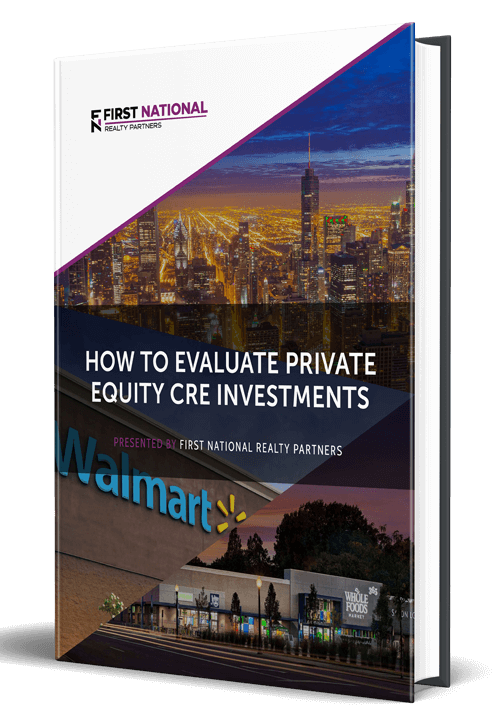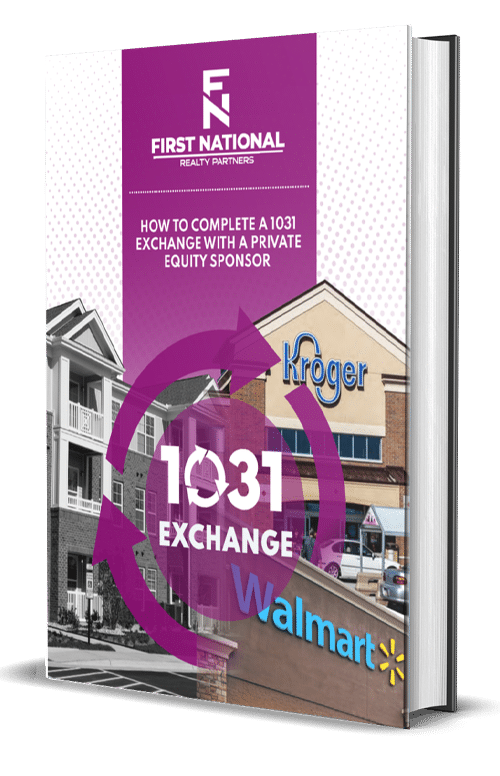In June of 2022, the United States reported an annual inflation rate of 9.1% – the highest reading in more than 40 years. There are many complicated and variable reasons behind this number, but there is no doubt about the impact – it is a negative for the economy and makes the investment environment more challenging, but not impossible.
In this article, we are going to discuss investing in an inflationary environment – including why it is challenging and which investments tend to work best. By the end, readers will have enhanced knowledge about the risks and challenges of investing in a high inflation cycle and will be able to use this information as part of their pre-investment due diligence process.
At First National Realty Partners, we specialize in the acquisition and management of grocery store anchored retail centers. If you are an accredited investor and would like to learn more about our current opportunities, click here.
What is Inflation and Why Does It Matter?
Before discussing the specifics of investing in an inflationary environment, it first makes sense to define this term and highlight why it matters.
What is Inflation?
Inflation is the gradual rise in the price of goods and services over time. In a really simple example, consider the price of a bottle of Coca-Cola over time. When it was first introduced in the late 1880s, the price of a 6.5 ounce bottle was 5 cents. In 2022, the price of a 12 ounce bottle ranges from $1.50 to $1.75 – a significant increase over the years no doubt due to the increased cost of raw ingredients, transportation, overhead, and logistics.
Inflation is measured by changes in something called the Consumer Price Index (CPI), which is a “measure of the average change over time in the prices paid by urban consumers for a market basket of consumer goods and services.” Generally, the Federal Reserve tries to maintain a target inflation rate of 2% – 3% annually, which is significantly lower than the 9.1% June 2022 reading.
Why Does It Matter?
High inflation readings are very impactful to the economy for a number of reasons, but there are three that are most notable.
First, it decreases the purchasing power of an individual’s money. At 9.1% annual inflation, an individual who does nothing with their money loses 9.1% of their purchasing power in one year. Over a multi-year period this can be a devastating loss – particularly for retirees on a fixed income.
Second, it means that investors have to earn a higher return on their assets just to maintain the same level of purchasing power. In any given year, a 9.1% return on investment would be pretty good, but at 9.1% inflation, it means that investors didn’t actually make any return on their investment, net of inflation. To get ahead, they would have to beat this number, which can be difficult to do.
Finally, and perhaps most importantly, it means that the Federal Reserve is going to take steps – via monetary policy – to combat it, which can have negative effects for the economy as a whole. The Federal Reserve’s primary tool for fighting inflation is interest rates. When inflation is high, they will raise them, which makes everything more expensive, causing a decline in economic activity. So, the primary challenge of investing into an inflationary environment is that the Federal Reserve is likely to take steps to purposely curb demand, which can have a negative impact on investment returns.
Protecting Your Finances in An Inflationary Environment
For investors, the key to protecting their finances in an inflationary environment is to ensure that their assets earn a return that is higher than the rate of inflation. To demonstrate this point, consider two scenarios in an environment where inflation is 9.1% annually.
In scenario #1, an investor has all of their capital invested in a portfolio of bonds including US treasuries and high yield bonds because they like the relative safety and the income provided by the coupon payments/dividends. This portfolio returns a very respectable 6% annually. In most years, this would be just fine, but in a year with 9.1% inflation, this investor actually lost 3.1% net of inflation.
In scenario #2, the investor takes more risk and places their capital in a basket of individual stocks, REITs, exchange traded funds (ETFs), and mutual funds. This portfolio produces a return of 12%, which seems great, but actually turns out to be just 2.9% net of inflation.
The point is this, to protect their assets in a period of high inflation, investors must steer their capital towards assets that are going to produce a return that will beat inflation. In general, this means away from the relative safety of bonds and towards riskier assets like stocks, index funds, mutual funds, and real estate/REITs that can deliver a return that outpaces inflation.
What Are The Best Investments For Inflation?
As a general rule, the best investments in a period of rising inflation are those that have the pricing power to keep up – meaning companies who have the ability to raise the price of their products and services to keep up with inflation. There are a few prime examples that fall into this category.
Real Estate
Real estate assets, especially the income producing variety, are a classic example of an asset class that can be a good inflation hedge. There are two reasons for this.
First, property owners have the ability to charge higher prices as inflation rises. Of course there may be some contractual constraints on this, but when leases come up for renewal, rental rates can be adjusted to the then current market rate, which reflects the impacts of inflation.
Second, inflation makes everything more expensive – including real estate. So, the combination of the ability to increase cash flow and rising prices means that real estate can act as a great place to park money during a high inflation environment.
Commodities
A commodity is an economic good that can be bought or sold. Often commodities are agricultural or raw materials that are used to produce something else. Examples of commodities are things like corn, wheat, precious metals, oil, and natural gas.
Commodities can be a good inflation hedge because their prices also rise during inflationary periods. A good example of this is the price of lumber, which has soared in recent years, from $536 per 1,000 board feet to $1,441. This far outpaces inflation.
For individual investors buying commodities directly can be difficult. But, there are sector specific mutual funds or ETFs that have commodity exposure that are probably a better fit.
Bonds
In general, bonds are not a great option for periods of high inflation. However, there is one type of bond, known as an “IBond” that can be purchased directly from the US Treasury and their return is tied to inflation. The exact return calculation can be complex, but the return on IBonds has both a fixed rate component and one that is tied to the rate of inflation that is reset at regular intervals. At the time of writing, the interest rate paid on IBonds is 9.62%, which is a very strong return, especially because it is backed by the US government.
In addition, there is another type of bond, known as a Treasury Inflation Protected Security or TIPS for short. Like an IBond, these are securities that are purchased directly from the US Treasury and whose return is tied to the rate of inflation.
For investors who prefer the relative safety of bonds, these two types may be an option worth considering adding to an investment portfolio.
Stocks / Equities
From a risk standpoint, stocks and equities are at the higher end, but this level of risk may be necessary to generate a return that outpaces inflation. But, not all stocks are created equal. As a general rule, the threat of higher interest rates is a negative for growth stocks like those in the technology industry. On the other hand, value stocks and those that pay a healthy dividend are likely to be a better fit for an inflationary environment.
For example, a technology company like Uber that depends on low cost capital to grow their business is much more likely to suffer in a higher rate environment than a steady dividend payer like Walgreens whose business is less levered to low cost capital and more steady through all phases of the economic cycle.
Of course it is important to note that all of the points above are meant to be general in nature only. For specific advice, it is always a good idea to work with a financial advisor who can help with specific allocation decisions that are tailored to an individual’s risk tolerance, time horizon, return objectives, and personal investment strategy.
Advantages and Disadvantages of Investing During Inflation
Every challenge is an opportunity and there are advantages and disadvantages of investing during a period of high inflation.
The biggest advantage is that investors with patience, discipline, and a clear strategy can find some excellent deals in stocks, bonds, and real estate that have been beaten up by the macroeconomic environment. In addition, the income produced by dividends can help tide investors over until inflation is brought under control.
The primary disadvantage is volatility. The stock market and the economy in general do not like the uncertainty brought on by inflation. In many cases, there are two major concerns: (1) how much are interest rates going to rise; and (2) how badly will those higher rates damage economic growth? As the answers to these questions become clearer, the volatility tends to moderate, but it may take months or years. This is why investing in an inflationary environment takes patience and conviction in the investment strategy to see it through to better times.
Summary of Investing During Inflation
Inflation is defined as the gradual rise in the price of goods and services over time – as measured by changes in the consumer price index (CPI).
It is the job of the Federal Reserve to keep inflation in a target range of 2% – 3% annually, but there are times where it falls out of this range and their primary tool to get it back in line is to raise or lower interest rates.
When inflation is high, interest rates move up, which serves to curb demand and bring inflation back in line. However, this broader slowdown in economic activity may have a detrimental impact to overall economic conditions.
When inflation is high, investors must take steps to protect their finances from an erosion of purchasing power. In many cases, this means migrating capital towards investments that tend to be a good inflation hedge like real estate, commodities, IBonds, and value stocks with strong dividend payouts.
The major advantage of investing in an inflationary environment is that investors can find good deals in certain asset classes, but it may take some patience and discipline to hold on until economic conditions improve. The downside is the volatility of an inflationary environment.
Interested In Learning More?
First National Realty Partners is one of the country’s leading private equity commercial real estate investment firms. With an intentional focus on finding world-class, multi-tenanted assets well below intrinsic value, we seek to create superior long-term, risk-adjusted returns for our investors while creating strong economic assets for the communities we invest in.
If you are an Accredited Real Estate Investor and want to learn more about our investment opportunities, contact us at (800) 605-4966 or info@fnrpusa.com for more information.






